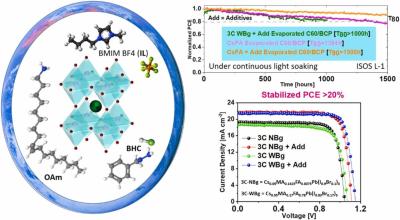Researchers at University of Rome “Tor Vergata”'s CHOSE (Centre for Hybrid and Organic Solar Energy), Greatcell Italy, ISM-CNR and ENEA have studied a standard triple cation perovskite (∼1.58 eV) and wider bandgap perovskite (∼1.63 eV) with intention of finding a common strategy to build a robust device stable over time independently of the perovskite used.
The scientists used a combination of additives inside the perovskite ink: ionic liquid 1-Butyl-3 methylimidazolium tetrafluoroborate (BMIM-BF4), alkylamine ligands oleylamine (OAm) and benzylhydrazine hydrochloride (BHC). The recent work reveals that the combination of these additives helps to improve the efficiency and stability of the entire device, reaching a power conversion efficiency up to 21.3% and over 20% for both types of perovskite and stability beyond 1000 h under continuous light soaking.
The universal applicability of this method was further applied to a robust methylammonium free perovskite, leading to an impressive stability both under light soaking and under 85 °C, showing T90 > 1500 h and T80 > 8658 h, respectively: the solar cells modified with the additive mixture retained 95 % of their efficiency after 1000 h under light soaking at 45 °C and 100 % of their efficiency after 1500 h of stress at 85 °C.
The choice of BMIMBF4, OAm, and BHC as perovskite additives is driven by the different ways these additives improve the quality of the perovskite absorber when they are added to the perovskite ink. By acting on different aspects of the device passivation, the team showed it possible to combine them to achieve a step-by-step improvement of the device performance.


